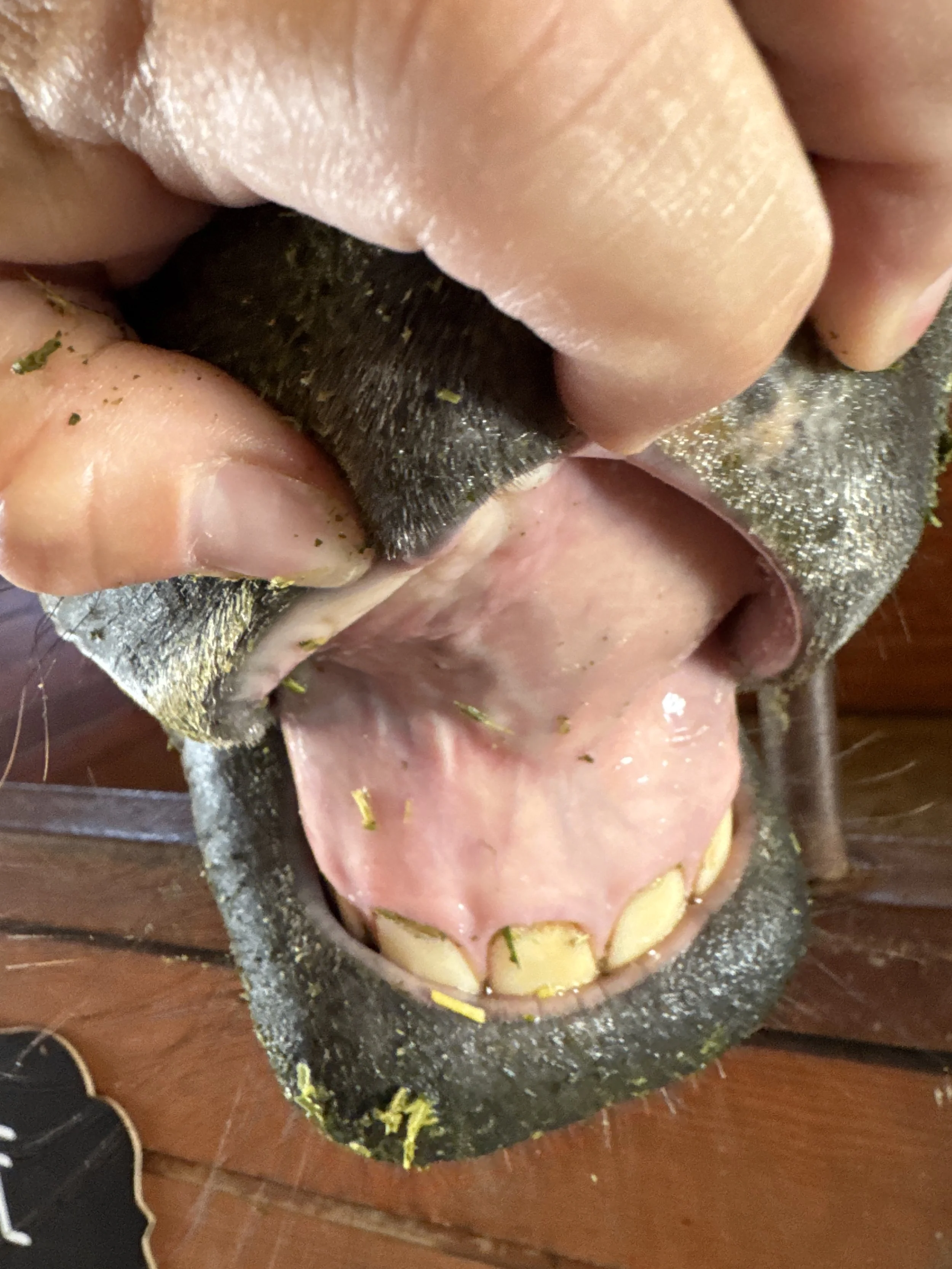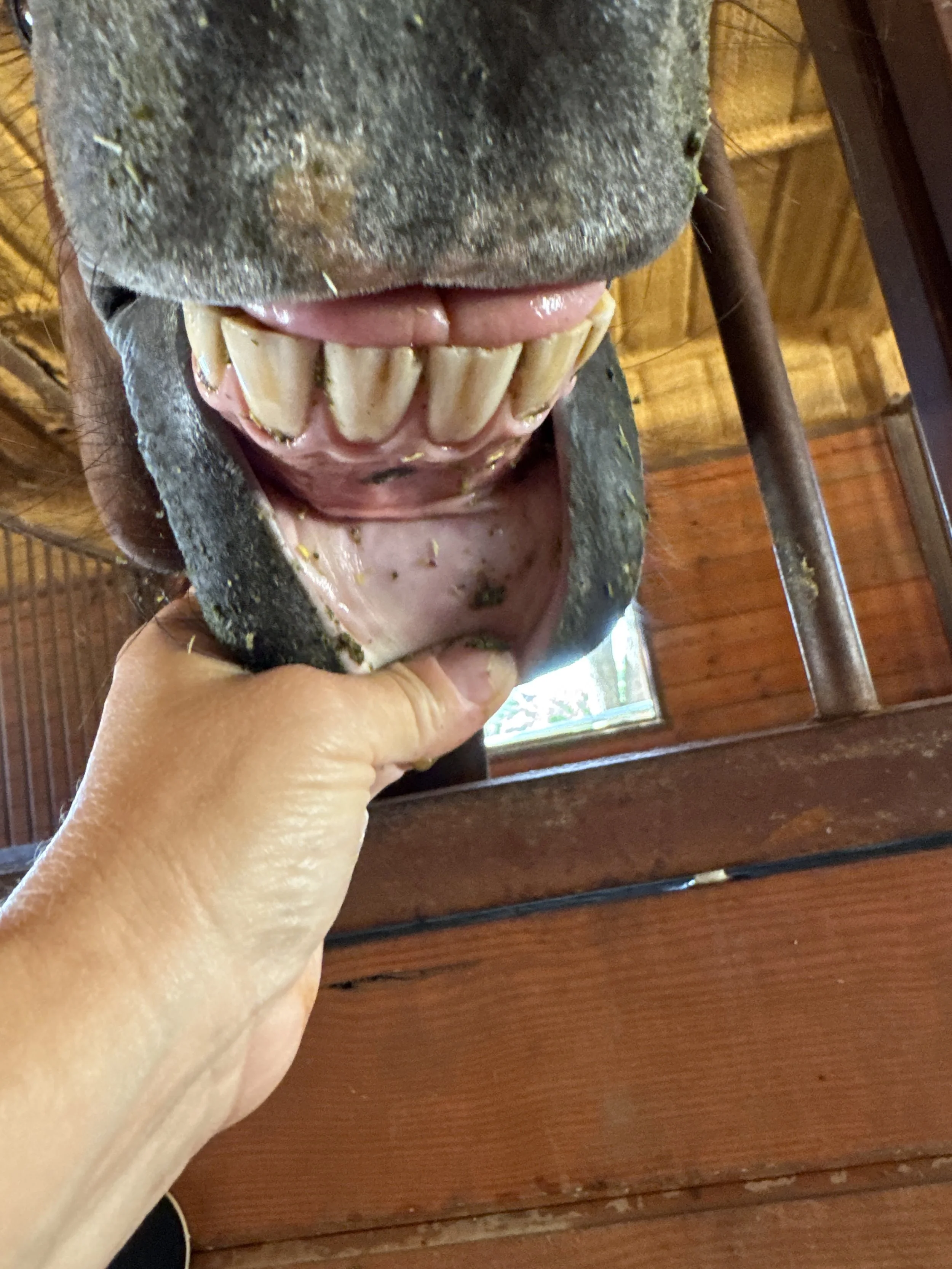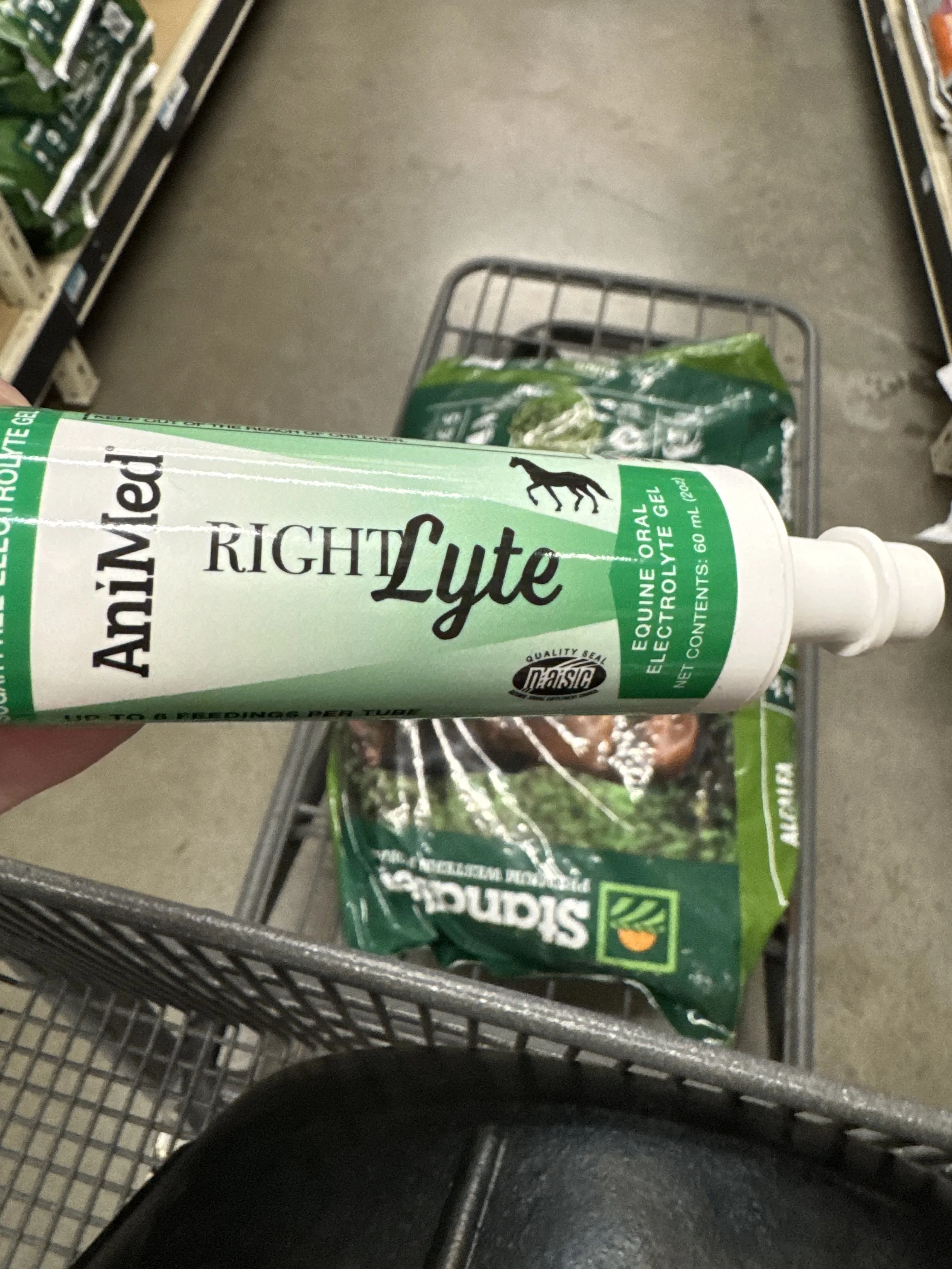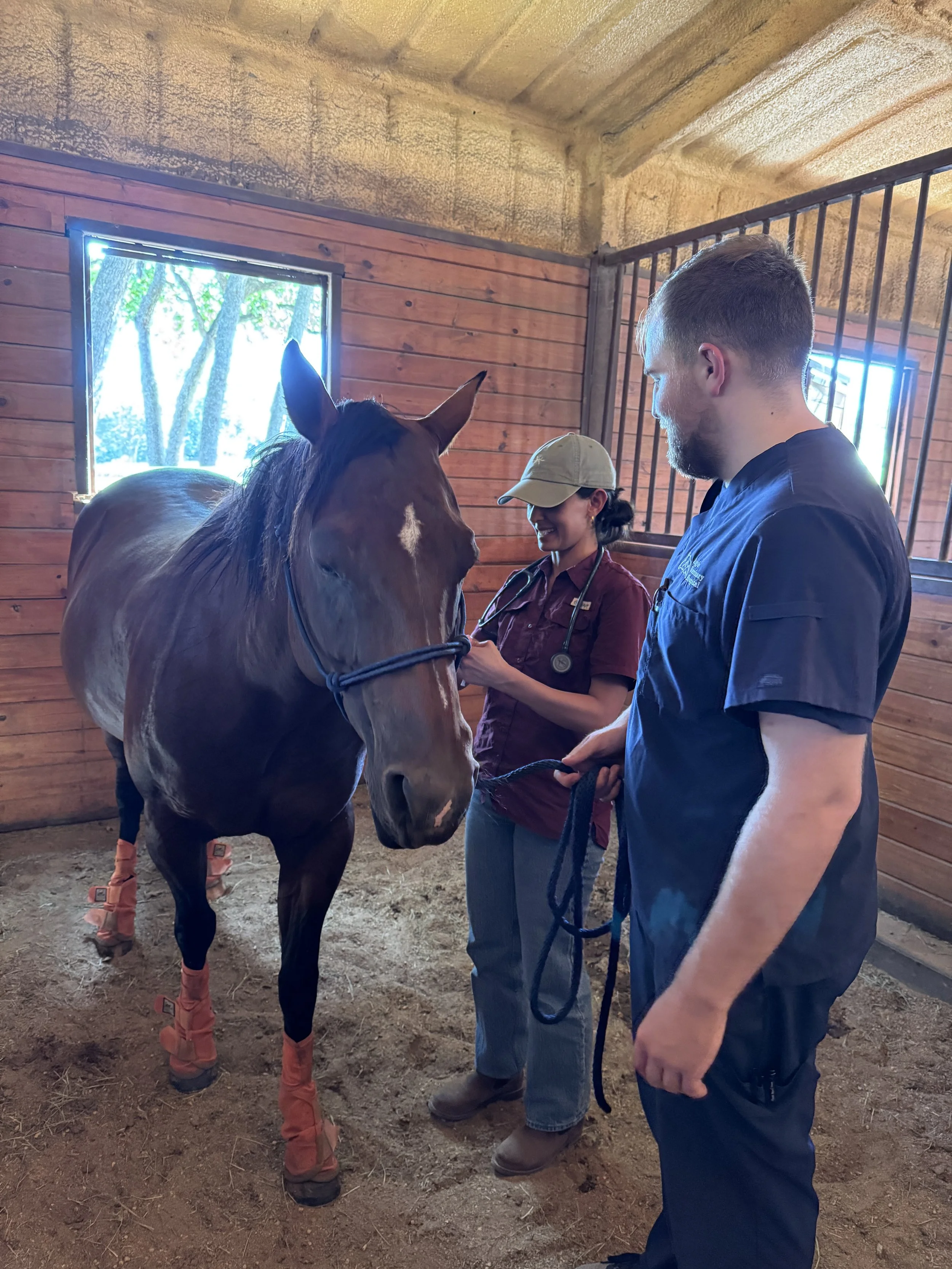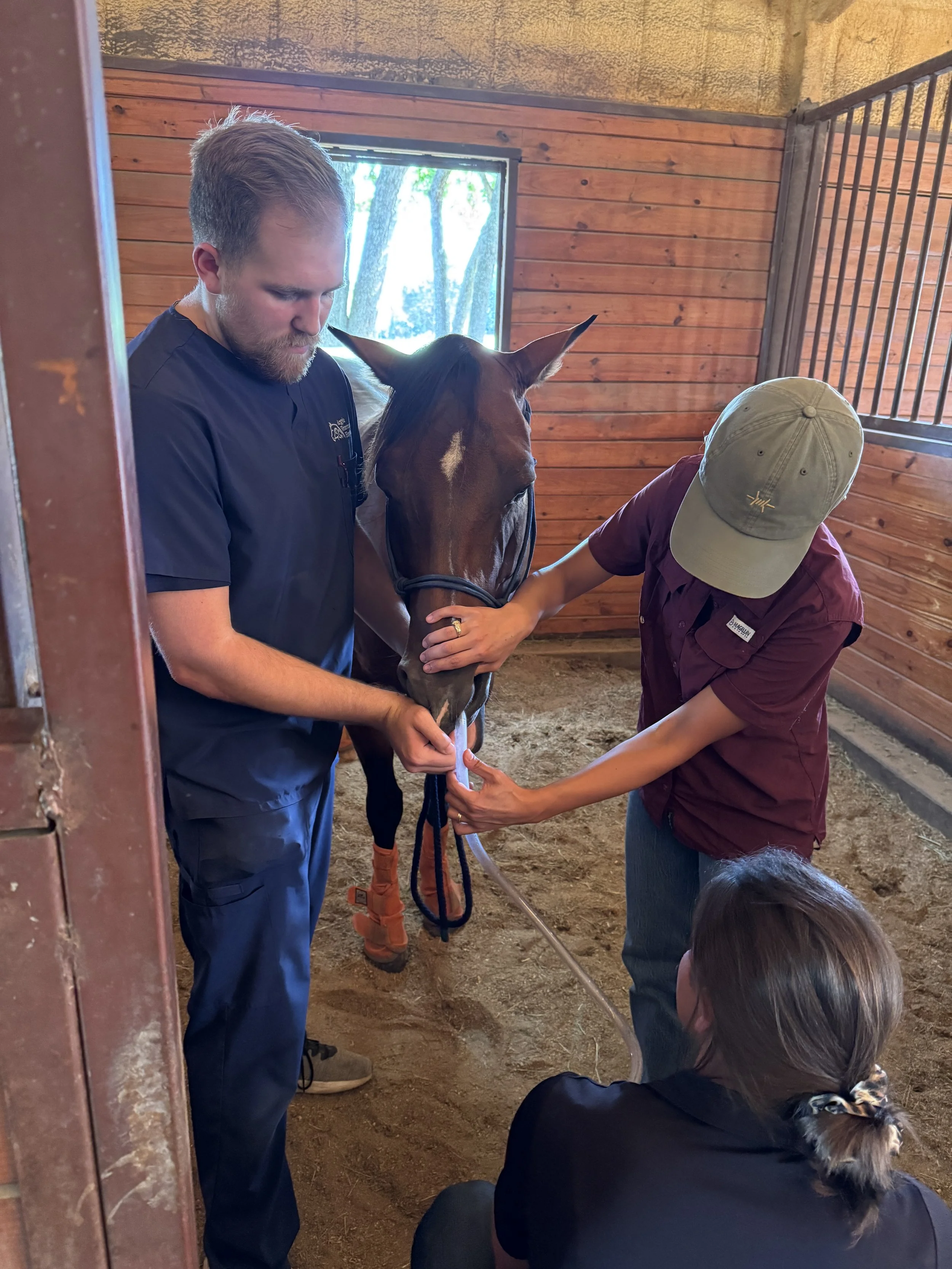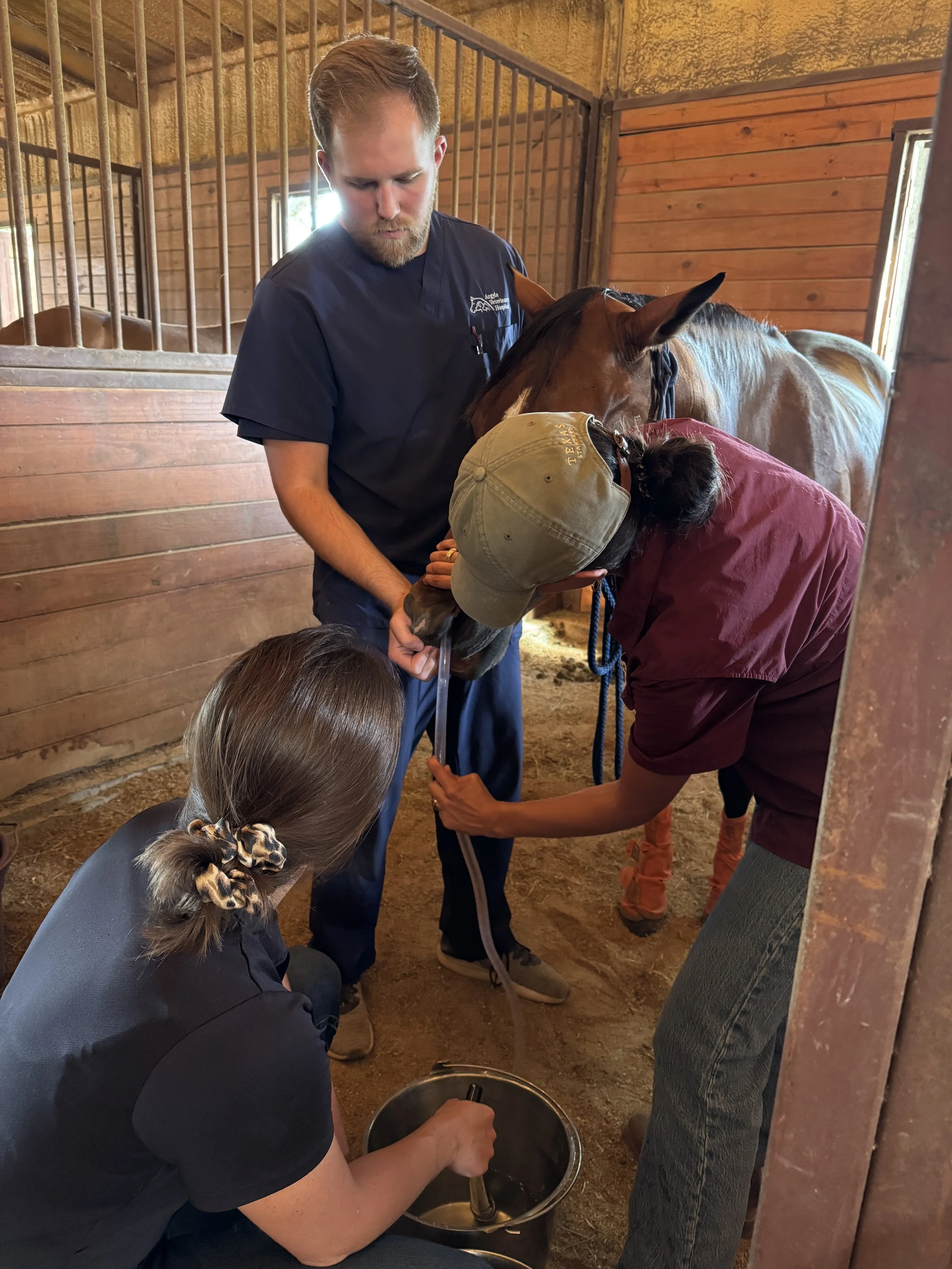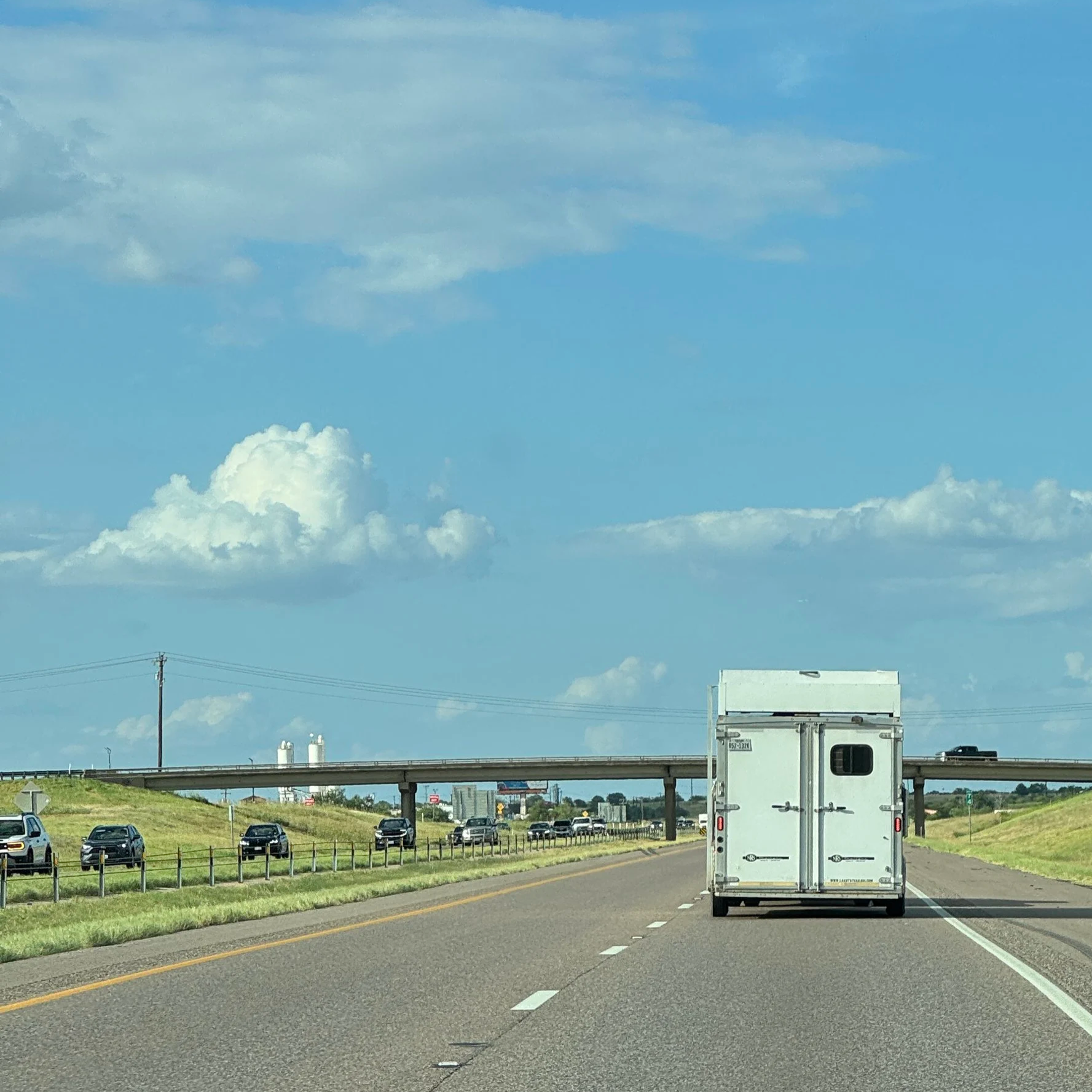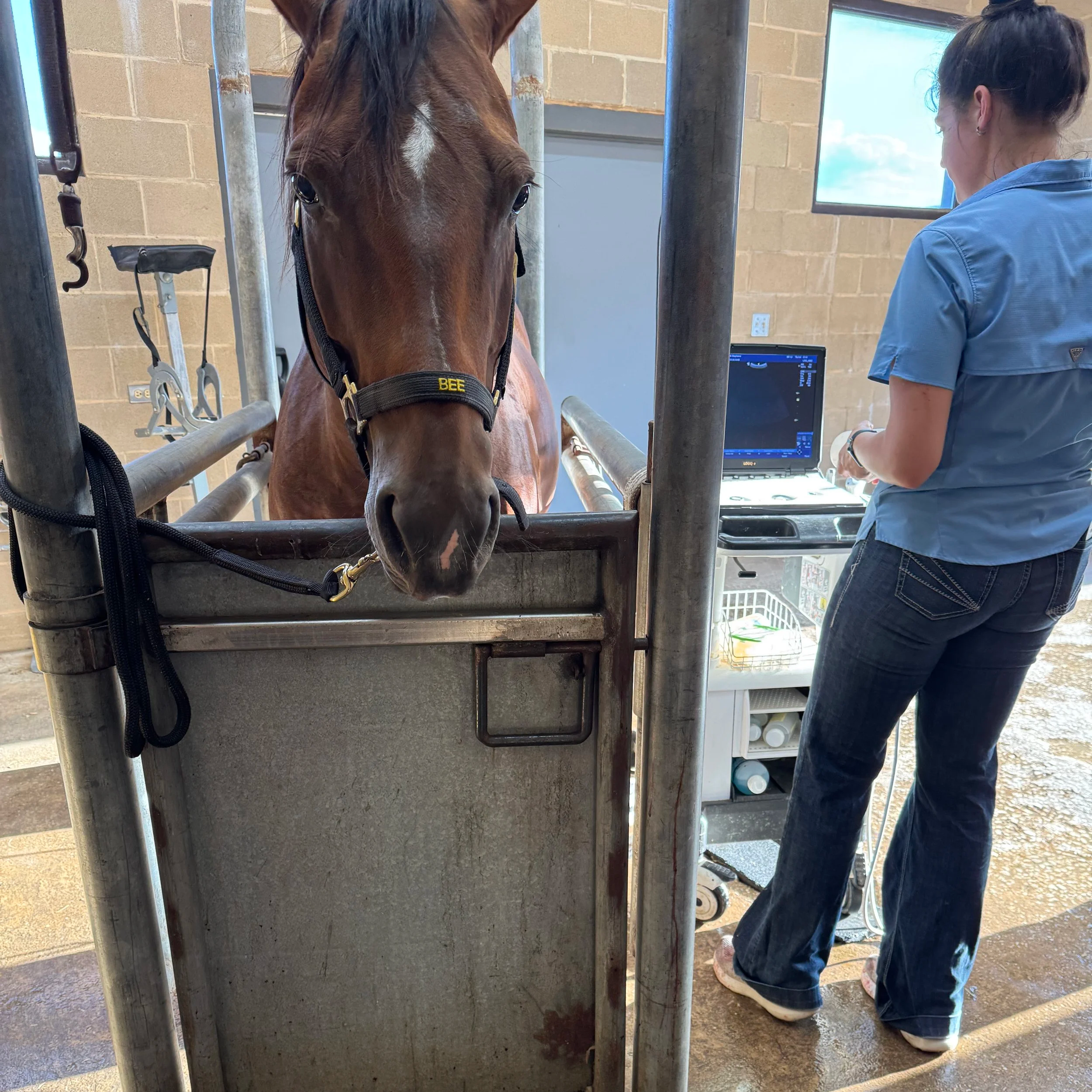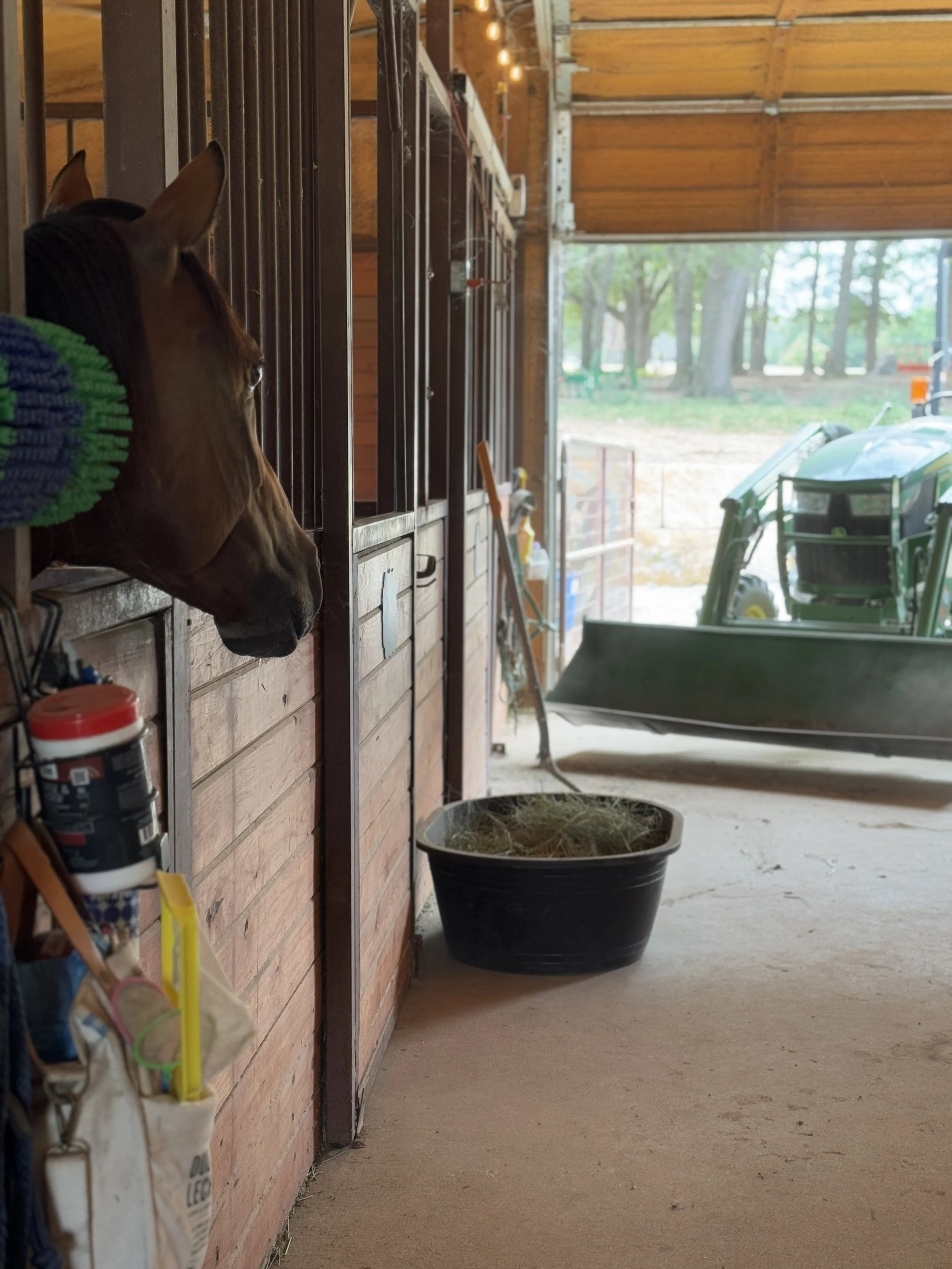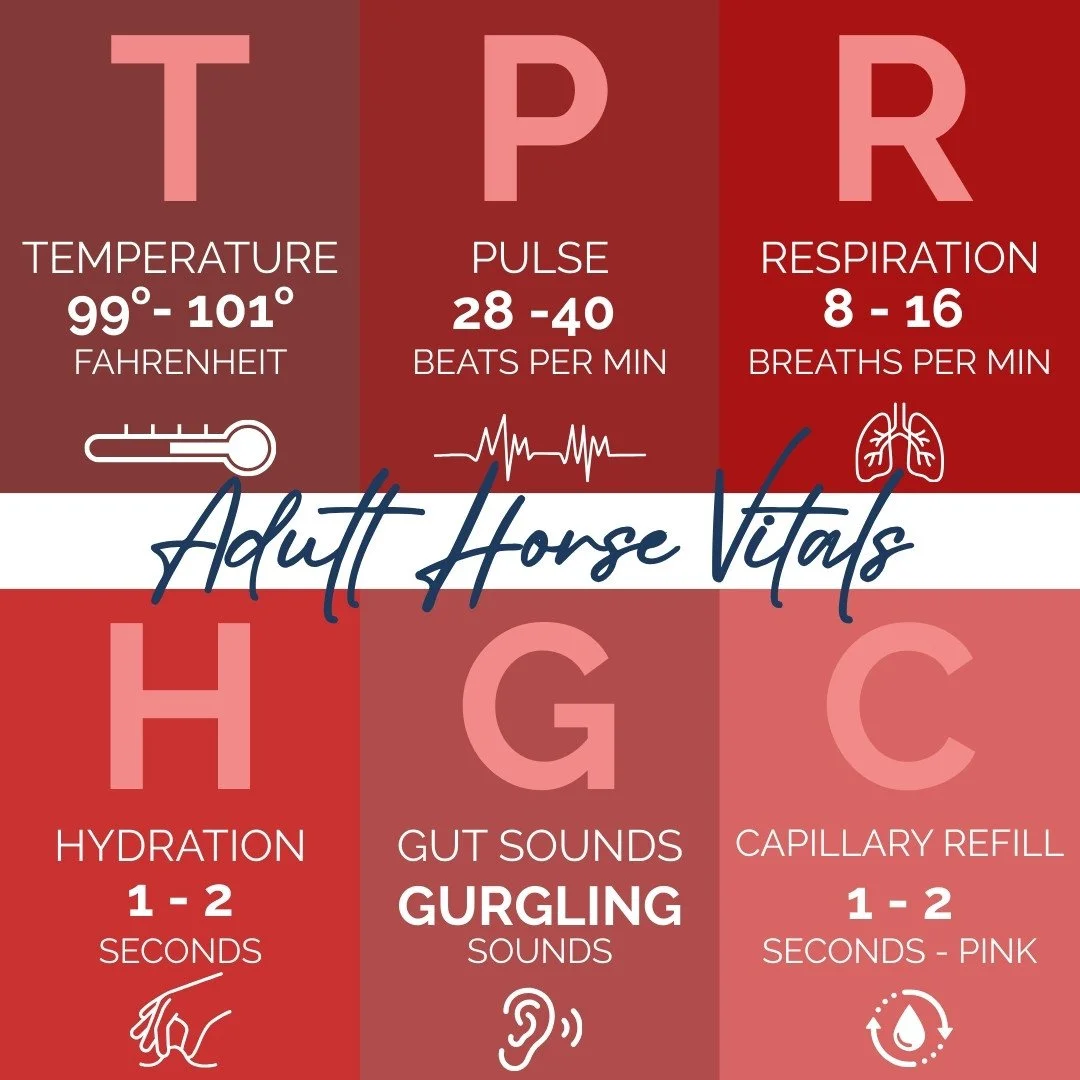August 22, 2025: What Bee Taught Me This Week
Horses are grazers by nature. In the wild, they move and eat almost constantly, keeping their digestive systems in motion. At the barn, that’s still their “job”—to nibble hay, graze grass, and happily crunch their grain all day.
So when I arrived at the barn Saturday morning and found Bee standing in the corner of her stall with her head down, ignoring both her grain and her hay, my heart dropped.
When a horse goes off feed, it’s rarely just a “she’s not hungry” situation. Horses are creatures of routine, and their digestive systems are delicate. Refusing food is one of the earliest and most reliable signs that something is wrong.
First Steps: Triage at the Barn
With the help of Haley, our barn manager, we began running through possibilities. The Texas heat has been relentless, with upper 90s and higher for weeks, so dehydration was at the top of the list. We started with a quick gum check. To do this, you press a finger firmly on the gum above the teeth until it blanches white, then release. This is called the capillary refill time (CRT). Healthy gums are bubblegum pink, and color should return within one to two seconds. A slower return can indicate dehydration, poor circulation, or even shock—and is always a reason to call your vet.
Bee’s gums were very pale pink, almost white, which raised our concern. To encourage hydration, we soaked her regular feed in water, hoping she’d take in some fluids along with it. Bee was a hard no on the watered-down grain.
Could it be colic? For those new to horse ownership, colic is a general term for abdominal pain in horses, often caused by gas, impaction, or other digestive issues. It can range from mild discomfort to life-threatening, and because horses cannot vomit, anything that blocks their digestive system can quickly turn critical.
We removed her hay, gave her a dose of Banamine (a common pain reliever for horses), and began monitoring her closely.
Hours of Worry and No Input or Outputs
For several hours, I tried everything to tempt Bee—alfalfa pellets, electrolytes, carrots, watermelon, fresh water. Nothing worked. Horses usually love alfalfa, so her refusal was especially alarming.
Barn friends Alicia and Michael, who had gone through colic with their horse Silver less than a year ago, pointed out that Bee wasn’t showing some of the classic colic signs, such as:
Looking at or biting the flank — a sign of abdominal pain
Pawing at the ground — restless behavior from discomfort
Rolling or repeatedly lying down and getting up — an attempt to “roll it out”
Stretching out as if to urinate — but without urinating
Sweating without exercise — a stress response
Restlessness — pacing, circling, or shifting weight frequently
Instead, she was showing other concerning symptoms:
Loss of appetite — refusing grain, hay, and even favorite treats
Increased heart rate and breathing — both elevated at rest
Dullness or depression — standing still with her head down, uninterested in her surroundings
Reduced manure — little to no droppings in her stall
By late afternoon, with no improvement, I called the emergency veterinarian, Argyle Animal Veterinary Hospital. While waiting, we even tried playing “digestion music for horses”—a soothing track that’s supposed to encourage bowel movement. Wouldn’t you know, after about 20 minutes Bee finally produced a #2! It was a huge relief and another sign that colic might not be the culprit.
I can’t say enough good things about the Argyle team. Dr. Diaz and Dr. LaRue, , along with their technician, arrived at the barn in less than an hour. Calm, efficient, and thorough, they immediately put both Bee and me at ease. Their exam included listening to her respirations, bowels, lungs, and heart rate, along with taking her temperature: 104.1. For a horse, that’s dangerously high and a strong indicator of infection.
To rule out colic completely, they sedated her and performed a nasogastric intubation—passing a tube down her nose into her stomach to check for fluid backup or impaction. Thankfully, no signs of colic appeared. Still, her rapid breathing and elevated temperature were concerning enough that they recommended immediate transport to the hospital. And in true professionalism, they even called ahead to Weems & Stephens Equine Hospital to properly pass the torch and ensure Bee had a spot reserved in case she needed to be admitted overnight.
In the middle of all of this, I was reminded how grateful I am for family support. Once Payton heard Bee wasn’t well, she showed up at the barn without me even asking. I nearly lost it when she walked in. Having her there to listen to the vets and talk shop with them when they called to say they had arranged a spot at Weems & Stephens was such a comfort. It made a very stressful situation feel a little less overwhelming.
Off to the Hospital
Ashley hauling Bee to the hospital, thank you God for amazing friends.
Thanks to Ashley Holland, who graciously hauled Bee, we got her to Weems & Stephens Equine Hospital in Aubrey, Texas. Dr. Stancof and the team there did a full workup: blood tests, nasal swabs, and ultrasounds of her lungs and belly. Everything came back clear except an elevated white blood cell count, showing her body was fighting an infection.
Bee was a good patient during her ultrasound.
By then, her fever had dropped to 102.5, and in the best turn of events all day, she started showing interest in grass. For a horse owner, there are few sweeter sights than watching your horse reach for food after a day of worry.
The vets believed Bee was dealing with a non-contagious virus. They offered to keep her overnight for observation, or let me manage her care at home by:
Checking her temperature three times a day
Administering Banamine if her fever spiked above a certain point
Continuing electrolytes (which she hates — they’re a thick, apple-flavored paste, and Bee isn’t a fan of anything apple)
Soaking her grain to sneak in extra hydration
Stall rest so we could carefully monitor all inputs and outputs
Ashley kindly hauled Bee back home and tucked her into her stall with a flake of alfalfa, while I made a quick stop for barn essentials: a rectal thermometer and rubbing alcohol (the medical kind—though after a day like that, a stiff drink didn’t sound like a bad idea either). For those wondering, rubbing alcohol can be used on a horse’s body to help reduce fever quickly by cooling the skin as it evaporates.
Up to that point, Bee hadn’t received any medications other than the dose of Banamine Haley administered that morning. When I returned to the barn around 10:00 p.m. armed with my supplies, I took her temperature. Relief washed over me as the thermometer read 101.2. Her fever had dropped solidly into a safer range. I hung her alfalfa in a hay net so she would nibble more slowly, topped off her water buckets, and whispered a prayer over her stall for a safe night before heading home.
Bee back home Saturday night. Forelock a mess but resting comfortably after a quick fly spray and some alfalfa.
By early Sunday morning, Bee was bright-eyed, nickering for breakfast, and making it clear she was ready to leave her stall. She still needed stall rest for monitoring, but I brushed her, cooled her off, and spent the day spoiling her with electrolytes and extra treats. Her temperature stayed in the normal range for horses all day, and her outputs—without going into too much detail here (ewww)—looked reassuringly normal.
Of course, Bee didn’t spend her stall rest in boredom. She kept herself busy supervising renovations to Vita’s stall down the aisle, watching the whole process like a foreman keeping the crew in line. By Monday morning, with two straight days of normal temperatures, healthy appetite, and steady inputs and outputs, we felt confident turning her back out to pasture with the rest of the herd.
Bee supervising the maintenance work on bestie Vita’s stall.
I’ll continue monitoring her temperature three times a day through Tuesday, then taper down to once a day starting Wednesday. For now, I’m simply thankful for a barn full of support, a quick-acting vet team, and a tough little mare who seems determined to bounce back to her usual self.
Vita (and can you spot Neville?) wondering why Bee is on stall rest.
Lessons Learned: Why Eating Matters
This weekend reminded me how important it is to notice the smallest changes in your horse’s routine. If your horse doesn’t finish breakfast, don’t shrug it off. Loss of appetite is one of the earliest and clearest signs of trouble.
Here’s what to remember:
Watch their habits. Horses thrive on consistency, so any change—especially in eating or drinking—is a warning sign.
Act quickly. Colic and other conditions can escalate in hours, not days.
Call your vet. Even if it feels like overreacting, it’s always better to be safe.
Have support. I’m grateful for Haley, Ashley, and our vet teams for helping us navigate this scare.
Quick Reference: Vital Signs in Horses
Knowing what’s normal makes it easier to spot when something is wrong. Here are the basics every horse owner should know:
Temperature: 99–101°F (fever begins at 102°F or higher)
Heart Rate (Pulse): 28–40 beats per minute at rest
Respiratory Rate: 8-16 breaths per minute at rest, some sources say 10–24 breaths per minute at rest
Hydration: A skin pinch should go back to the original position in 1-2 seconds. If it stays up longer, your horse could be dehydrated.
Gut Sounds: You should hear gurgling or rumbling on both sides of the belly. Silence can be a red flag.
Capillary Refill Time (CRT): 1–2 seconds (press on the gums until they blanch, then release—pink color should return quickly)
If your horse’s vitals fall outside these ranges—or if something just doesn’t seem right—always call your veterinarian.
Bee is home now, with orders for careful monitoring, temperature checks, and we have medication on hand if needed. For now, I’m just thankful to see her eating and being her sassy self again. Because when a horse stops eating, the carrot fund takes a hit—but the heart takes a bigger one.

